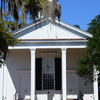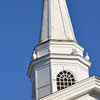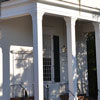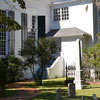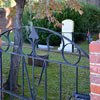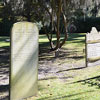Kingston Presbyterian Church and Cemetery
Located on a bluff overlooking Kingston Lake in Conway's historic district, Kingston Presbyterian Church was established by the Scots-Irish immigrants who settled Kingston Township in the early 18th century.
Photo Gallery
Click icon to enlarge image. Use arrow keys or
click large picture to cycle through the gallery.
|
Kingston Presbyterian Church and Cemetery
800 Third Avenue,
Conway, SC 29526
Itinerary
Map: View Map and Directions Web Site: www.kingstonpc.org Phone: 843-248-4200 Email: kingstonpc@sccoast.net Add This Site to Your Itinerary
Site Description
Established by the Scots-Irish immigrants who first settled Kingston Township in the 1730s and '40s, Kingston Presbyterian Church is located at 800 Kingston Avenue in Conway. The church and its historic cemetery overlook Kingston Lake, a prong of the Waccamaw River, which was the main highway for the river town of Kingston in the Colonial Era. The nearest Anglican Church, the official government denomination in the British colony of South Carolina, lay almost 40 miles down the Waccamaw from Kingston, and most church-going settlers in the wilderness township were Presbyterian "dissenters". By the time Kingston was renamed Conwayborough (later Conway) in 1800, the Presbyterians were outnumbered by a growing population of Baptists and Methodists due to evangelism among those denominations in the Second Great Awakening.
Access and Admission
On the eve of the Civil War in 1858, the log structure used by Kingston Presbyterian Church was replaced by the handsome steeple-topped worship center still in use by the church. Shrouded by moss-draped live oak trees, the church features classic Antebellum Greek Revival architecture, marked by three square columns that tower over a front portico. (Square columns were reportedly less expensive to construct than round ones.) The design was the work of a master mason named Otis Eaton who was a native of Bucksport, Maine. Inside the church today, visitors will find traditional white-washed walls, a 21-foot-high ceiling, a central pulpit that reflects the Protestant priority on preaching the Word, and a balcony that reflects both local style and culture. Horry County had a very small Antebellum slave population compared to neighboring Georgetown County, and the few slave owners in Conway treated their slaves as family, bringing them to church with them - hence the slave balcony. (In Georgetown, larger churches had no slave balconies because many slave owners built chapels for their slaves on their plantations.) According to local tradition, the finial atop the church steeple was crafted by a local steamboat captain, Thomas W. Daggett, who is said to have also constructed the homemade sea mine that sank the Federal warship USS Harvest Moon in Winyah Bay during the Civil War. Outside, the church cemetery features graves dating to the early 19th century, including the graves of local Confederate veterans, Captain Daggett, and the unusual glass-encased tombstones of the Beatty children who tragically drowned in the nearby lake. The handsome, adjacent, brick classroom and fellowship center was built in the mid-20th century. Kingston Presbyterian Church is on the National Register of Historic Places and visits may be arranged by contacting the church office. Site Access: Public
Tours and Events
Access Description: Sunday Service: 10:30 am Historic Registry: National Register - Church listed September 28, 2009 Cemetary listed August 5, 1986 Ownership: Church Guided Tours: Self
|
